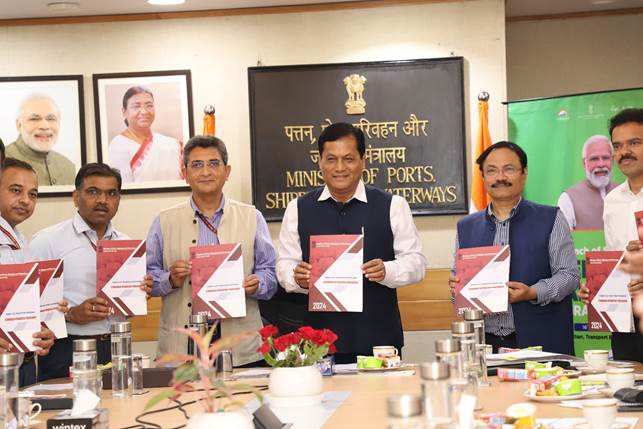Highlights:
Phase 1 of the GTTP will begin on October 1, 2024, and continue until December 31, 2027.
The program is expected to involve an investment of around ₹1000 Crores in building these green tugs.
The Green Tug Transition Program is a pivotal initiative towards realizing the vision of a sustainable and green maritime sector in India.
GTTP aims at replacement of existing diesel-powered tugs with zero-emission tugs.

Auto Amazon Links: Could not resolve the given unit type, . Please be sure to update the auto-insert definition if you have deleted the unit.
Launch of the Green Tug Transition Program (GTTP)
On 16August 2024, Shri Sarbananda Sonowal, the Union Minister of Port Shipping and Waterways, officially launched the Standard Operating Procedure (SOP) for the Green Tug Transition Program (GTTP) in New Delhi. This program marks a significant step in India’s efforts to enhance environmental sustainability and advance its maritime sector by transitioning from conventional fuel-based harbor tugs to greener alternatives.
Overview of the Green Tug Transition Program
The GTTP is a major initiative under the ‘Panch Karma Sankalp’. Announced on May 22, 2023, by Shri Sarbananda Sonowal during the ‘Chintan Shivir’ event, the program aims to phase out conventional fuel-based harbor tugs at Indian Major Ports and replace them with green tugs powered by cleaner, more sustainable fuels.
Phase 1 Details
Phase 1 of the GTTP will begin on October 1, 2024, and continue until December 31, 2027. During this phase, four Major Ports—Jawaharlal Nehru Port Authority, Deendayal Port Authority, Paradip Port Authority, and V.O. Chidambaranar Port Authority—are set to procure or charter at least two green tugs each. These tugs will adhere to standardized designs and specifications provided by the Standing Specification Committee (SSC). An investment of approximately INR 1000 Crores is expected for building these green tugs. The first set will be battery-electric, with plans to adopt other green technologies like hybrid systems, methanol, and green hydrogen as they become available.
Minister’s Statement
Shri Sarbananda Sonowal commented, “The Green Tug Transition Program is a pivotal initiative towards realizing our vision of a sustainable and green maritime sector in India. This program not only aligns with our environmental goals but also strengthens our commitment to ‘Make in India,’ promoting domestic innovation and manufacturing in the maritime industry.”
Impact on the Domestic Industry
The GTTP is anticipated to significantly benefit the domestic tug industry. All tugs built under this program will be constructed in Indian shipyards, supporting the Government of India’s ‘Make in India’ initiative. The program is also expected to create considerable employment opportunities in shipbuilding and ship design, as noted by Shri TK Ramachandran, Secretary of the Ministry of Ports, Shipping, and Waterways (MoPSW).
Long-term Goals
By the end of 2040, the goal is for all tugs operating in Indian Major Ports to transition to green technologies, ensuring a standardized and eco-friendly fleet across the country. Additionally, beyond 2033, any new tug built in India for use in Indian ports will need to comply with the ASTDS-GTTP standards.
Alignment with Maritime India Vision 2030
The GTTP is aligned with the Maritime India Vision 2030 (MIV 2030), launched by Prime Minister Shri Narendra Modi in 2020. The vision aims to enhance India’s maritime sector by setting ambitious targets such as sourcing 60% of each major port’s power demand from renewable energy and achieving a 30% reduction in carbon emissions per ton of cargo by 2030. The Maritime Amrit Kaal Vision 2047, introduced in 2023, further specifies goals for reducing greenhouse gas emissions from port vessels by 30% by 2030. Harbor tugs, essential for port operations like berthing and ship assistance, are ideal candidates for adopting green technologies to reduce emissions while maintaining operational efficiency.
Conclusion
The Green Tug Transition Program demonstrates the Government’s commitment to sustainability and innovation in the maritime sector. By driving the shift towards greener technologies, the GTTP is setting the stage for a cleaner, more sustainable future for India’s ports and maritime operations.
Source:PIB
Auto Amazon Links: Could not resolve the given unit type, . Please be sure to update the auto-insert definition if you have deleted the unit.
ग्रीन टग ट्रांजिशन प्रोग्राम (जीटीटीपी) : भारत में हरियाली को बढ़ावा
Highlights:
जीटीटीपी का पहला चरण एक अक्टूबर, 2024 को शुरू होगा और 31 दिसंबर, 2027 तक जारी रहेगा
इस कार्यक्रम में ग्रीन टग के निर्माण में लगभग 1000 करोड़ रुपये का निवेश होने की संभावना है
ग्रीन टग ट्रांजिशन प्रोग्राम देश में एक टिकाऊ और हरित समुद्री क्षेत्र के हमारे विजन को साकार करने की दिशा में एक महत्वपूर्ण पहल है.
जीटीटीपी का उद्देश्य मौजूदा डीजल-संचालित टगों को शून्य-उत्सर्जन वाले टगों से बदलना है.
ग्रीन टग ट्रांजिशन प्रोग्राम (जीटीटीपी) का शुभारंभ
आज, केंद्रीय पत्तन, पोत परिवहन और जलमार्ग मंत्री श्री सर्बानंद सोनोवाल ने नई दिल्ली में ग्रीन टग ट्रांजिशन प्रोग्राम (जीटीटीपी) के लिए मानक संचालन प्रक्रिया (एसओपी) का आधिकारिक शुभारंभ किया। यह ऐतिहासिक पहल पारंपरिक ईंधन आधारित हार्बर टग से अधिक हरित और टिकाऊ विकल्पों की ओर संक्रमण को प्रोत्साहित करेगी, जो पर्यावरणीय स्थिरता और भारत के समुद्री क्षेत्र के विकास के लिए एक महत्वपूर्ण कदम है।
ग्रीन टग ट्रांजिशन प्रोग्राम (जीटीटीपी) का उद्देश्य और महत्व
जीटीटीपी ‘पंच कर्म संकल्प’ के तहत एक प्रमुख पहल है, जिसका उद्देश्य भारतीय प्रमुख बंदरगाहों पर संचालित पारंपरिक ईंधन आधारित हार्बर टग को चरणबद्ध तरीके से समाप्त करना और उन्हें स्वच्छ, अधिक टिकाऊ वैकल्पिक ईंधन से संचालित ग्रीन टग से बदलना है। यह पहल भारत के समुद्री परिचालन को डीकार्बोनाइज करने में एक महत्वपूर्ण कदम साबित होगी, जिससे पर्यावरणीय प्रभाव कम होगा और टिकाऊ प्रौद्योगिकियों को बढ़ावा मिलेगा।
जीटीटीपी का चरण 1
जीटीटीपी का पहला चरण 1 अक्टूबर, 2024 से शुरू होगा और 31 दिसंबर, 2027 तक चलेगा। इस अवधि के दौरान, चार प्रमुख भारतीय बंदरगाहों—जवाहरलाल नेहरू पत्तन प्राधिकरण, दीनदयाल पत्तन प्राधिकरण, पारादीप पत्तन प्राधिकरण और वी.ओ. चिदंबरनार पत्तन प्राधिकरण—को कम से कम दो ग्रीन टग खरीदने या किराए पर लेने की जिम्मेदारी दी जाएगी। ये टग स्थायी विनिर्देश समिति (एसएससी) द्वारा जारी मानकीकृत डिज़ाइन और विनिर्देशों के अनुसार बनाए जाएंगे। इस कार्यक्रम में ग्रीन टग के निर्माण पर लगभग 1000 करोड़ रुपये का निवेश होने की उम्मीद है। पहले सेट के टग बैटरी-इलेक्ट्रिक होंगे, और भविष्य में हाइब्रिड, मेथनॉल, और ग्रीन हाइड्रोजन जैसी अन्य हरित तकनीकों को अपनाने का प्रावधान होगा।
मंत्री श्री सर्बानंद सोनोवाल का बयान
श्री सर्बानंद सोनोवाल ने कार्यक्रम के शुभारंभ पर टिप्पणी करते हुए कहा, “ग्रीन टग ट्रांजिशन प्रोग्राम हमारे देश में टिकाऊ और हरित समुद्री क्षेत्र की दिशा में एक महत्वपूर्ण पहल है। यह कार्यक्रम न केवल हमारे पर्यावरणीय लक्ष्यों को साकार करता है, बल्कि ‘मेक इन इंडिया’ के प्रति हमारी प्रतिबद्धता को भी मजबूत करता है, और समुद्री उद्योग में घरेलू नवाचार और विनिर्माण को बढ़ावा देता है।” उनका बयान इस पहल की महत्वता और इसके व्यापक लक्ष्यों को स्पष्ट करता है।
घरेलू उद्योग पर जीटीटीपी का प्रभाव
जीटीटीपी से भारतीय टग उद्योग को महत्वपूर्ण लाभ होने की उम्मीद है। इस कार्यक्रम के तहत निर्मित सभी टग भारतीय शिपयार्ड में बनाए जाएंगे, जो भारत सरकार की ‘मेक इन इंडिया’ पहल के तहत स्थानीय विनिर्माण को प्रोत्साहित करेगा। इस कार्यक्रम के जरिए जहाज निर्माण और जहाज डिजाइन में रोजगार के महत्वपूर्ण अवसर भी पैदा होंगे, जैसा कि श्री टीके रामचंद्रन, सचिव, मंत्रालय ने उल्लेख किया।
दीर्घकालिक लक्ष्य और मानक
2040 के अंत तक, भारतीय प्रमुख बंदरगाहों में संचालित सभी टगों को ग्रीन टग में बदलने की योजना है, जिससे एक मानकीकृत, पर्यावरण के अनुकूल बेड़ा सुनिश्चित होगा। इसके अतिरिक्त, 2033 के बाद, भारत में निर्मित किसी भी नए टग को एएसटीडीएस-जीटीटीपी मानकों का पालन करना होगा, जो कि ग्रीन तकनीकों को अपनाने में एक महत्वपूर्ण मानक स्थापित करेगा।
मैरीटाइम इंडिया विज़न 2030 के साथ जीटीटीपी का संरेखण
जीटीटीपी का उद्देश्य 2020 में प्रधानमंत्री श्री नरेंद्र मोदी द्वारा प्रस्तुत मैरीटाइम इंडिया विज़न 2030 (एमआईवी 2030) के साथ मेल खाता है। यह विज़न भारत के समुद्री क्षेत्र को सुरक्षा, स्थिरता, और पर्यावरणीय जिम्मेदारी में वैश्विक स्तर पर अग्रणी बनाने के लिए प्रमुख रणनीतियाँ प्रस्तुत करता है। इसके तहत, प्रत्येक प्रमुख बंदरगाह की बिजली की मांग का 60 प्रतिशत नवीकरणीय ऊर्जा से प्राप्त करने और 2030 तक प्रति टन कार्गो में कार्बन उत्सर्जन को 30 प्रतिशत कम करने का लक्ष्य रखा गया है।
इसके अलावा, 2023 में प्रस्तुत मैरीटाइम अमृत काल विज़न 2047, प्रमुख बंदरगाहों के लिए 2030 तक ग्रीनहाउस गैस उत्सर्जन को 30 प्रतिशत तक कम करने का लक्ष्य निर्धारित करता है। हार्बर टग, जो बर्थिंग, अनबर्थिंग और जहाज सहायता जैसे महत्वपूर्ण कार्यों के लिए उपयोग होते हैं, हरित प्रौद्योगिकियों को अपनाने के लिए आदर्श उम्मीदवार हैं, क्योंकि ये प्रौद्योगिकियाँ उत्सर्जन को कम करते हुए परिचालन दक्षता बनाए रख सकती हैं।
निष्कर्ष
ग्रीन टग ट्रांजिशन प्रोग्राम सरकार की समुद्री क्षेत्र में स्थिरता और नवाचार के प्रति व्यापक प्रतिबद्धता को दर्शाता है। यह पहल भारत के बंदरगाहों और समुद्री परिचालनों के लिए एक स्वच्छ और हरित भविष्य का मार्ग प्रशस्त करती है, जो पर्यावरणीय सुधारों और घरेलू उद्योग को बढ़ावा देने में सहायक होगी.
स्रोत:PIB




